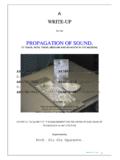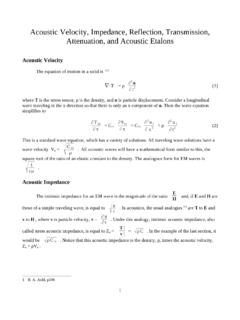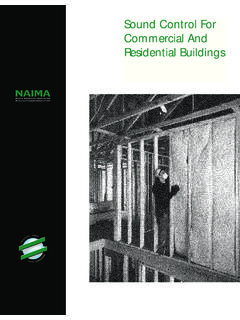Transcription of How NRR Is Calculated - Howard Leight
1 How NRR Is CalculatedWhen I compare the values in the attenuation charts with the NRR on the package, the NRRis much lower than the average attenuation . How is the NRR Calculated ?It is quite an ambitious calculation to measure a hearing protector s attenuation at a variety of frequencies on a fewtest subjects in the laboratory, input these values into a formula and derive a single-number rating that can be applieduniversally to all users in all noise settings. If you have studied the attenuation charts on boxes of hearing protectors, youcan see the Noise Reduction Rating (NRR) is not simply a mathematical average ofthe attenuation values.
2 In 1979, Environmental Protection Agency1standardized the NRR formula that we still use today to rate hearing are the significant steps used in calculating the NRR, and an explanation of why each step is important:Table 1. Howard Leight Max Single-Use Earplug attenuation | NRR 33 dB Testing according to ANSI , R1979 Sound Source Volume 1/Issue 6a May 2005 Bacou-DallozHearing Safety Group7828 Waterville Road, San Diego, CA 92154 Tech Support ph. 800/977-9177 fax 619/661-8131 Cust Service ph. 800/430-5490 fax 401/232-3110 Frequency in Hz125250500100020003150400063008000 Mean attenuation Deviation Sound Source Volume 1/Issue 6a May 2005 Laboratory Testing:At least ten subjects are tested with properly-fitted hearing protectors (called occludedear ) and tested again without hearing protectors (called open ear ), across a range of test frequencies.
3 Thedifference between the open ear and occluded hearing tests gives us the attenuation of the hearing subject is tested three times, meaning there are at least thirty attenuation measurements at each variability in these measurements (the Standard Deviation ) is Calculated and the thirty attenuation valuesare then averaged to give us the Mean attenuation in dB at each frequency. These Mean attenuation values,as well as the Standard Deviations, appear in the attenuation chart on each box or bulk package of hearingprotectors distributed in the Deviation:To account for individual variation in fitting hearing protectors out in the real world(remember, the laboratory only tested a minimum of ten subjects), a correction factor of two standard devia-tions is subtracted from each attenuation value.
4 By subtracting two standard deviations, we can generalizethe results from a small sample of ten subjects to a larger population: for a population which is properly fit-ted with the HPD in the same manner as the laboratory subjects, 98% of the population would be expectedto achieve these same attenuation values in the from Hypothetical Noise:To account for some differences between the laboratory test soundsand real-world noise, the adjusted attenuation values (mean minus two standard deviations) are subtractedfrom hypothetical noise levels some standardized noise levels at each frequency band.
5 This step is criticalso that we might apply the final NRR to a hearing protector user, and not a laboratory microphone whichdetects sound differently than a human Addition:In this step, we combine all the adjusted attenuated levels into a single values are measured in decibels, which are logarithmic numbers. (From math class, you may recalllogarithms are related to the exponent of a number, or the power to which a number is raised.) Logarithmscannot just be added mathematically (80 dB plus 80 dB does not equal 160 dB). They are added in a specialway that accounts for the exponents. Correction Factor:Finally, a 3 dB correction is built into the NRR calculation to account for the fact that notall noise spectra are the same.
6 The assumed noise spectrum used in the NRR calculation may be quite differentthan the actual spectrum in the workplace, so this 3 dB correction is a cushion for spectral uncertainty. (Note:There is an additional 7dB correction factorused in applying the NRR to A-weighted noise measurements,also for spectral uncertainty. See Sound Source #4 A- and C-Weighted Measurements. )The result of this lengthy calculation is the NRR. The NRR is significantly lower than the average attenuation across all frequencies because the NRR contains corrections and cushions to make it applicable to a broader population.
7 Whileit is not a perfect real-world measure of attenuation , the NRR is the most standardized method currently in use fordescribing a hearing protector s attenuation in a single number. The NRR estimates the amount of protection achievableby 98% of users in a laboratory setting when hearing protectors are properly fitted. Brad Witt, MA, CCC-AAudiology & Regulatory Affairs ManagerBacou-Dalloz Hearing Safety GroupFootnote:1 The EPA labeling standard is defined in Code of Federal Regulations (CFR) 40, Part 211, Subpart B Hearing Protective Source is a periodic publication of the Bacou-Dalloz Hearing Safety Group, addressing questions and topics relating to hearing conservation and hearing protection.
8 WARNING: It does not provide important product warnings and instructions. Bacou-Dalloz recommends all users of its products undergo thorough training and that all warningsand instructions provided with the products be thoroughly read and understood prior to use. It is necessary to assess hazards in the work environment and to match the appropriatepersonalprotective equipment to particular hazards that may exist. At a minimum, a complete and thorough hazard assessment must be conducted to properly identify the appropriatepersonal protective equipment to be used in a particularworkenvironment.
9 FAILURETO READ AND FOLLOW ALL PRODUCT WARNINGS AND INSTRUCTIONS AND TO PROPERLYPERFORM A HAZARD ASSESSMENT MAY RESULT IN SERIOUS PERSONAL INJURY, ILLNESS OR DEATH. For further information on this or other hearing conservation topics, contactTechnical Support at 800/977-9177. Bacou-Dalloz Hearing Safety Grou





